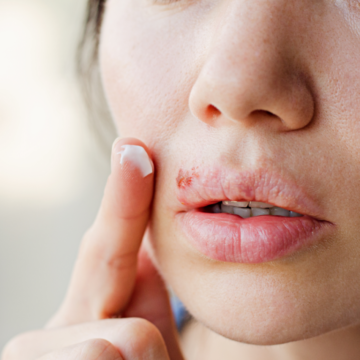The Herpes Simplex Virus (HSV) is one of the most common medical conditions to affect humanity. Indeed, the World Health Organisation estimates two-thirds of people under 50 have the strain known as HSV-1. Another 417 million people have HSV-2, better known as genital herpes. That’s more than the entire population of western Europe.
There are in fact around 100 known strands of the herpes virus, of which eight affect humans. In fact, if you caught chickenpox as a child, you’ve already had one form of herpes (known scientifically as HHV-3).
So, what is the difference between HSV-1 and HSV-2 and what should you do if you think you’ve caught this common illness?
What is the Herpes Simplex Virus?
The Herpes Simplex Virus is a kind of virus which affects the skin and nervous system. It is best known for creating outbreaks of sores which can range from mild and uncomfortable, to extremely painful.
Liquid-filled sores typically appear near mucous membranes on the skin then, after a few days, the sores break, leaving a yellowish crust on the skin. Outbreaks typically last for around two weeks.
The first herpes outbreak is typically the most painful and is often accompanied by headaches, flu-like symptoms and painful sores. Subsequent outbreaks tend to be less severe and appear less frequently over time. These outbreaks are most likely to happen when your immune system is ‘down’ for some reason (fighting a cold, sleep-deprived etc).
How to tell the difference between HSV-1 and HSV-2
The most obvious difference between HSV-1 and HSV-2 is where you experience outbreaks.
If you have HSV-1, your outbreaks will usually occur on the skin on your lips and around the mouth. Sometimes the sores will appear inside your mouth, and they can appear elsewhere on your skin. HSV-1 can sometimes also appear near your eyes.
HSV-1 outbreaks often only happen about once per year, although everybody is different and sometimes they occur more often – other carriers never experience symptoms.
If you have HSV-2, your outbreaks will occur on and around your genitals, buttocks and rectum:
- Women: You will notice the sores anywhere on the vulva (outside of your vagina), and often on the lips. They may also appear inside your vagina too and around your groin area.
Genital herpes can be especially painful for women and may cause a burning sensation when you pee.
- Men: You will normally notice the sores appearing on the penis itself, as well as on your testicles and around your groin. In (rare) cases the sores may appear inside the penis, making it very painful to pee.
HSV-2 outbreaks are usually more frequent than HSV-1, typically happening 4-5 times per year. However, as with HSV-1, this will vary from one person to another.
What is the biological difference between HSV-1 and HSV-2?
Under a microscope, HSV-1 and HSV-2 look very similar and share near-identical characteristics and behaviours. They have the same biological origins but the strands mutated and diverged at some point in the past to target different parts of the body.
Both forms of Herpes Simplex Virus infect the mucous membranes in the body – most often those around the mouth or the genitals. After the initial infection, they will lie dormant in your system until something triggers them to reactivate.
HSV-1 lies dormant in nerve cells near the base of the neck, and when outbreaks occur, will most often appear on the face or neck. HSV-2, meanwhile, lies dormant in nerve cells near the base of the spine, and when outbreaks occur usually appears around the buttocks and genitals.
An HSV-1 or HSV-2 outbreak can be triggered by a range of things – from over-exposure to the sun, another illness, HIV, having sex or even a strong emotional state such as grief. The virus will then replicate and travel along the nerve pathways to the skin and carriers will experience an outbreak.
HSV-1 vs HSV-2: which is worse?
A simple HSV-1 vs HSV-2 comparison isn’t really the most useful way of understanding the virus. And in either case, the Human Simplex Virus is a highly manageable condition. With an efficient herpes treatment, outbreaks can be easily and quickly brought under control. While it’s an annoying condition, herpes rarely has any serious complications.
That said, despite genital herpes carrying more social stigma and outbreaks happening more often, HSV-1 is potentially more dangerous. If a HSV-1 outbreak occurs in or near the eyes, there’s a chance it may develop into ‘ocular herpes’ which is a potentially serious infection and can even lead to blindness.
On the other hand, HSV-2 has less risk of serious complications, although pregnant women with genital herpes should talk to their gynaecologist. There is a small chance of transmitting the disease to the child – a dangerous infection for newborns known as neonatal herpes.
Can you tell if someone has herpes by looking?
No, unless they are having an outbreak, it is not possible to tell for sure whether someone has herpes just by looking. Indeed, they themselves may not be aware they’re carrying the virus either, since it’s often asymptomatic. And of course, unless you’re a trained sexual health professional, you could easily misdiagnose something entirely different.
While it’s ‘easiest’ to catch herpes when someone is having an outbreak on their skin, you can still catch it when there are no visible signs either. So, just looking at a person’s face or body won’t tell you if they have herpes or not.
How to get rid of herpes
There is currently no treatment which will ‘cure’ you of herpes. Once you get herpes, you will have it for life (unless a cure is discovered in future). However, as noted above, this is a highly manageable condition. There are many treatments for herpes which reduce the pain and make sure your outbreaks clear up fast so you get on with living your life.
In the end, there’s very little difference between HSV-1 and HSV-2. They’re both annoying and bothersome illnesses. But, at the same time, they’re both extremely easy to manage and there’s no reason for herpes to hold you back.



